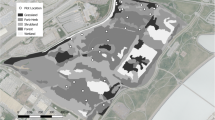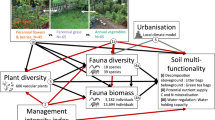Abstract
Brownfield sites contribute significantly to urban biodiversity due to their high spatio-temporal dynamics and their transient character. Plant species richness is, among other factors, contingent on vegetation structure. In this study, we examined plant species richness, vegetation height, vegetation density and soil parameters of a chronosequence of urban brownfield sites in Bremen and Berlin, Germany. These parameters were linked to successional age using single and multiple linear regression. Most biotic and abiotic variables differed significantly between sites with and without brick rubble in the soil, indicating a strong effect of site history on vegetation development. Soil parameters of the sites were not clearly linked to site age. Vegetation height and density increased significantly over time. Additionally, height and density increased with soil phosphorus content and water permeability of the soil, whilst plant available water only contributed to the model of vegetation density. Species richness increased with vegetation height but decreased with vegetation density. This indicates that species richness is maximised when a community comprises a mixture of early and mid-successional species. The results suggest that high plant species richness on sandy brownfield sites can be achieved by strong disturbances at an interval of 5 (±2) years. However, limiting soil resources can prolong this interval considerably. Management aiming to maximise plant species richness in urban brownfield sites should therefore take into account the interplay between soil resources and site age.


Similar content being viewed by others
References
Aerts R, Chapin FS (2000) The mineral nutrition of wild plants revisited: a re-evaluation of processes and patterns. In: Aerts R, Chapin FS (ed) Advances in ecological research, vol 30. pp 1–67
Angold PG, Sadler JP, Hill MO, Pullin A, Rushton S, Austin K et al (2006) Biodiversity in urban habitat patches. Sci Total Environ 360:196–204 doi:10.1016/j.scitotenv.2005.08.035
Anon. [Arbeitsgruppe-Boden] (1996) Bodenkundliche Kartieranleitung (KA4). Hannover (DE)
Backhaus K, Erichson B, Plinke W, Weiber R (2003) Multivariate analysemethoden. Springer, Berlin
Bakker JP, Olff H, Willems JH, Zobel M (1996) Why do we need permanent plots in the study of long-term vegetation dynamics? J Veg Sci 7:147–155 doi:10.2307/3236314
Bautista-Cruz A, del Castillo RF (2005) Soil changes during secondary succession in a tropical montane cloud forest area. Soil Sci Soc Am J 69:906–914 doi:10.2136/sssaj2004.0130
Bazzaz FA (1996) Plants in changing environments. Cambridge University Press, Cambridge
Blatt SE, Crowder A, Harmsen R (2005) Secondary succession in two south-eastern Ontario old-fields. Plant Ecol 177:25–41 doi:10.1007/s11258-005-2018-0
Bornkamm R (1986) Ruderal succession starting at different seasons. Acta Societatis Botanicorum Pol 55:403–419
Bornkamm R, Hennig U (1982) Experimental ecological study of succession of ruderal plant-communities on different soils. 1. Floristic composition of the vegetation. Flora 172:267–316
Bungard RA, Zipperlen SA, Press MC, Scholes JD (2002) The influence of nutrients on growth and photosynthesis of seedlings of two rainforest dipterocarp species. Funct Plant Biol 29:505–515 doi:10.1071/PP01137
Chadwick OA, Derry LA, Vitousek PM, Huebert BJ, Hedin LO (1999) Changing sources of nutrients during four million years of ecosystem development. Nature 397:491–497 doi:10.1038/17276
Chapin FS, Walker LR, Fastie CL, Sharman LC (1994) Mechanisms of primary succession following deglaciation at Glacier Bay, Alaska. Ecol Monogr 64:149–175 doi:10.2307/2937039
Chapin FS, Mooney HA, Matson PA (2002) Principles of terrestrial ecosystem ecology. Springer, New York
Cook WM, Yao J, Foster BL, Holt RD, Patrick LB (2005) Secondary succession in an experimentally fragmented landscape: community patterns across space and time. Ecology 86:1267–1279 doi:10.1890/04-0320
De Deyn GB, Raaijmakers CE, Van der Putten WH (2004) Plant community development is affected by nutrients and soil biota. J Ecol 92:824–834 doi:10.1111/j.0022-0477.2004.00924.x
Deutscher Wetterdienst (2006) Mean climate values for the period 1961 to 1990. http://www.dwd.de/de/FundE/Klima/KLIS/daten/online/nat/index_mittelwerte.htm.07-11-2006
DVWK [Deutscher Verband für Wasserwirtschaft und Kulturbau] (1996) Ermittlung der Verdunstung von Land-und Wasserflächen. Merkblätter zur Wasserwirtschaft 238. Wirtschafts und Verl.-Ges. Gas Wasser, Bonn
Effland WR, Pouyat RV (1997) The genesis, classification, and mapping of soils in urban areas. Urban Ecosyst 1:217–228 doi:10.1023/A:1018535813797
Fiala K, Tuma I, Holub P, Tesarova M, Jandak J, Pavkova A (2001) Importance of grass cover in reduction of negative processes in soil affected by air pollution. Rostlinna Vyroba 47:377–382
Foster BL, Tilman D (2000) Dynamic and static views of succession: testing the descriptive power of the chronosequence approach. Plant Ecol 146:1–10 doi:10.1023/A:1009895103017
Gilbert OL (1989) The ecology of urban habitats. Chapman and Hall, London
Gough L, Shaver GR, Carroll J, Royer DL, Laundre JA (2000) Vascular plant species richness in Alaskan arctic tundra: the importance of soil pH. J Ecol 88:54–66 doi:10.1046/j.1365-2745.2000.00426.x
Grime JP (1974) Vegetation classification by reference to strategies. Nature 250:26–31 doi:10.1038/250026a0
Grime JP (2001) Plant strategies, vegetation processes, and ecosystem properties. Wiley, Chichester (UK)
Härdtle W, von Oheimb G, Westphal C (2003) The effects of light and soil conditions on the species richness of the ground vegetation of deciduous forests in northern Germany (Schleswig–Holstein). For Ecol Manage 182:327–338 doi:10.1016/S0378-1127(03)00091-4
Hirzel A, Guisan A (2002) Which is the optimal sampling strategy for habitat suitability modelling? Ecol Modell 157:329–339 doi:10.1016/S0304-3800(02)00203-X
Horn R, Taubner H (1997) Wasser- und Lufthaushalt. In: Blume HP, Schleuß U (eds) Bewertung anthropogener Stadtböden. Schriftenreihe Institut für Pflanzenernährung und Bodenkunde Universität Kiel 38:32–65
Isermann M (2005) Soil pH and species diversity in coastal dunes. Plant Ecol 178:111–120 doi:10.1007/s11258-004-2558-8
Kleyer M, Biedermann R, Henle K, Poethke HJ, Poschlod P, Schröder B et al (2007) Mosaic cycles in agricultural landscapes of Central Europe. Basic Appl Ecol 8:295–309 doi:10.1016/j.baae.2007.02.002
Knops JMH, Tilman D (2000) Dynamics of soil nitrogen and carbon accumulation for 61 years after agricultural abandonment. Ecology 81:88–98
Korzeniak J (2005) Species richness and diversity related to anthropogenic soil disturbance in abandoned meadows in the Bieszczady Mts. (Eastern Carpathians). Acta Soc Bot Pol 74:65–71
Kühn I, Brandl R, Klotz S (2004) The flora of German cities is naturally species rich. Evol Ecol Res 6:749–764
Muratet A, Machon N, Jiguet F, Moret J, Porcher E (2007) The role of urban structures in the distribution of wasteland flora in the Greater Paris area, France. Ecosystems (N Y, Print) 10:661–671 doi:10.1007/s10021-007-9047-6
Nagler A, Cordes H (1993) Atlas der gefährdeten und seltenen Farn- und Blütenpflanzen im Land Bremen mit Auswertung für den Arten und Biotopschutz. Abh Naturwissenschaftlichen Vereins Bremen 42:580
Niemelä J (1999) Is there a need for a theory of urban ecology? Urban Ecosyst 3:57–65 doi:10.1023/A:1009595932440
Otto R, Krusi BO, Burga CA, Fernandez-Palacios JM (2006) Old-field succession along a precipitation gradient in the semi-arid coastal region of Tenerife. J Arid Environ 65:156–178 doi:10.1016/j.jaridenv.2005.07.005
Pauchard A, Aguayo M, Pena E, Urrutia R (2006) Multiple effects of urbanization on the biodiversity of developing countries: the case of a fast-growing metropolitan area (Concepcion, Chile). Biol Conserv 127:272–281 doi:10.1016/j.biocon.2005.05.015
Pickett STA (1989) Space-for-time substitution as an alternative to long-term studies. In: Likens GE (ed) Long-term studies in Ecology. Springer, New York, pp 110–135
Pickett STA, Cadenasso ML, Bartha S (2001) Implications from the Buell–Small succession study for vegetation restoration. Appl Veg Sci 4:41–52
Prach K, Pysek P, Bastl M (2001) Spontaneous vegetation succession in human-disturbed habitats: a pattern across seres. Appl Veg Sci 4:83–88
Pysek P, Chocholouskova Z, Pysek A, Jarosik V, Chytry M, Tichy L (2004) Trends in species diversity and composition of urban vegetation over three decades. J Veg Sci 15:781–788 doi:10.1658/1100-9233(2004)015[0781:TISDAC]2.0.CO;2
Radeloff VR, Mladenoff DJ, Boyce MS (2000) A historical perspective and future outlook on landscape scale restoration in the Northwest Wisconsin Pine Barrens. Restor Ecol 8:119–126 doi:10.1046/j.1526-100x.2000.80018.x
Rebele F (1994) Urban ecology and special features of urban ecosystems. Glob Ecol Biogeogr Lett 4:173–187
Rebele F, Lehmann C (2002) Restoration of a landfill site in Berlin, Germany by spontaneous and directed succession. Restor Ecol 10:340–347 doi:10.1046/j.1526-100X.2002.01026.x
Richter DD, Markewitz D, Wells CG, Allen HL, April R, Heine PR et al (1994) Soil chemical change during 3 decades in an old-field Loblolly-Pine (Pinus taeda L) ecosystem. Ecology 75:1463–1473 doi:10.2307/1937469
Ricketts T, Imhoff M (2003) Biodiversity, urban areas, and agriculture: Locating priority ecoregions for conservation. Conservation Ecology 8
Rudner M, Biedermann R, Schröder B, Kleyer M (2007) Integrated grid based ecological and economic (INGRID) landscape model—a tool to support landscape management decisions. Environ Model Softw 22:177–187 doi:10.1016/j.envsoft.2005.07.016
Schaffers AP (2002) Soil, biomass, and management of semi-natural vegetation—Part II. Factors controlling species diversity. Plant Ecol 158:247–268 doi:10.1023/A:1015545821845
Scheffer F (1984) Lehrbuch der Bodenkunde /Scheffer/Schachtschabel. 11. ed. Enke, Stuttgart.
Schlichting E, Blume HP, Stahr K (1995) Bodenkundliches Praktikum. Blackwell, Berlin
Strauss B, Biedermann R (2006) Urban brownfields as temporary habitats: driving forces for the diversity of phytophagous insects. Ecography 29:928–940 doi:10.1111/j.2006.0906-7590.04765.x
Sukopp H, Wittig R (1993) Stadtökologie. Fischer, Jena
Sykora KV, van den Bogert J, Berendse F (2004) Changes in soil and vegetation during dune slack succession. J Veg Sci 15:209–218 doi:10.1658/1100-9233(2004)015[0209:CISAVD]2.0.CO;2
Taubner H, Horn R (1999) Estimating soil water and air capacity from physical properties in anthropogenic substrate horizons. J Plant Nutr Soil Sci—Z Pflanzenernahr Bodenkd 162:33–40
Wang GH (2002) Plant traits and soil chemical variables during a secondary vegetation succession in abandoned fields on the loess plateau. Acta Bot Sin 44:990–998
Wegener U (1998) Naturschutz in der Kulturlandschaft. Fischer, Jena
Zehm A, Nobis M, Schwabe A (2003) Multiparameter analysis of vertical vegetation structure based on digital image processing. Flora 198:142–160
Acknowledgements
We thank Regine Kayser for laboratory work. This study was conducted as part of the TEMPO collaborative research project (Temporal Biodiversity and Building) and was supported by the German Federal Ministry of Education and Research in the framework of the programme “Biosphere Research—Integrative and Application-Oriented Model Projects” (BioTeam, BMBF, DE, grant 01LM0210).
Author information
Authors and Affiliations
Corresponding author
Rights and permissions
About this article
Cite this article
Schadek, U., Strauss, B., Biedermann, R. et al. Plant species richness, vegetation structure and soil resources of urban brownfield sites linked to successional age. Urban Ecosyst 12, 115–126 (2009). https://doi.org/10.1007/s11252-008-0072-9
Published:
Issue Date:
DOI: https://doi.org/10.1007/s11252-008-0072-9




